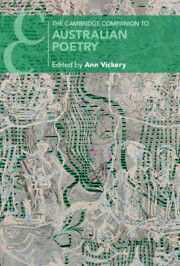Book contents
- The Cambridge Companion to Australian Poetry
- The Cambridge Companion to Australian Poetry
- Copyright page
- Contents
- Figures
- Contributors
- Acknowledgements
- Chronology
- Introduction
- Part I Change and Renewal
- Part II Networks
- Part III Authors
- Part IV Embodied Poetics
- 13 The Strength of Us as Women
- 14 “Country Snarled / in Borders”
- 15 Australian Poets in the Countries of Others
- 16 Writing the Body
- 17 Not the Poem Alone
- Part V Expanding Form
- Further Reading
- Index
- Cambridge Companions To …
- References
16 - Writing the Body
from Part IV - Embodied Poetics
Published online by Cambridge University Press: aN Invalid Date NaN
- The Cambridge Companion to Australian Poetry
- The Cambridge Companion to Australian Poetry
- Copyright page
- Contents
- Figures
- Contributors
- Acknowledgements
- Chronology
- Introduction
- Part I Change and Renewal
- Part II Networks
- Part III Authors
- Part IV Embodied Poetics
- 13 The Strength of Us as Women
- 14 “Country Snarled / in Borders”
- 15 Australian Poets in the Countries of Others
- 16 Writing the Body
- 17 Not the Poem Alone
- Part V Expanding Form
- Further Reading
- Index
- Cambridge Companions To …
- References
Summary
This chapter discusses how writing emerging out of Gay Liberation in the 1970s offered an alternative to the masculine heteronormativity that dominated the Australian literary tradition. Emphasised that the personal was political, it foregrounded private sensuality, an exploration of the everyday, and a critique of gay discrimination. The chapter traces the development of a diversifying community in the 1980s through writing collectives, anthologies, and journals. A broadening of the spectrum of LGBTQ+ poetry in the 1990s and 2000s was informed by queer understandings of sexuality. It saw lesbian writers test the limits of lyrical poetry and an era of mainstream popularity, as exemplified in Dorothy Porter’s The Monkey’s Mask. The chapter considers how LGBTQ+ poets of colour have critiqued ideas of national belonging and white subjecthood. It then discusses the exploration of embodiment, including the turn to autotheory by contemporary trans and genderqueer writers, resistance of ableist discourses, and the navigation of illness, such as AIDS, mental illness, and chronic pain.
Keywords
- Type
- Chapter
- Information
- The Cambridge Companion to Australian Poetry , pp. 274 - 291Publisher: Cambridge University PressPrint publication year: 2024



